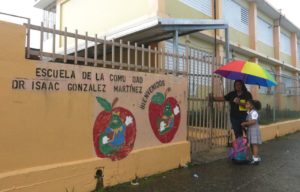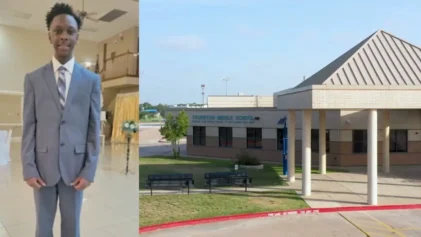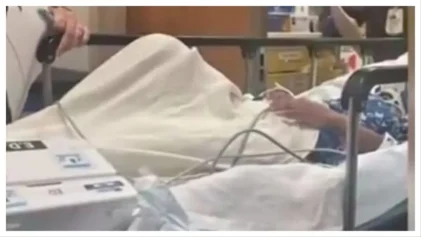
Ana Sanchez and her 8-year-old daughter Naiyari lock the gates of her school, The Dr. Isaac Gonzalez Martinez school, as part of their daily responsibilities in San Juan, Puerto Rico. (AP Photo/Danica Coto)
SAN JUAN, Puerto Rico (AP) — Puerto Rico is closing 179 public schools in a move expected to save more than $7 million amid a deep economic crisis that has sparked an exodus to the U.S. mainland in the past decade, officials said Friday.
More than 27,000 students will be moved elsewhere when their schools close at the end of May, said newly appointed Education Secretary Julia Keleher.
“We have a fiscal crisis and few resources and we’ve spent 10 years handing out nearly $3 billion in a system that hardly has any books,” she said. “We cannot keep doing what we’re doing because we don’t have the resources.”
The news about the school closures raised concerns it could speed up the ongoing exodus from Puerto Rico. Nearly 450,000 people over the last decade have already left for Florida and other parts of the U.S. mainland to flee the worsening economic crisis.
Officials initially had said 184 schools were closing but then announced at the last minute that five of those schools would remain open.
The school shutdown announced Friday will be the largest mass closure of schools in the island’s history, with officials saying it will in part lead to millions of dollars in savings a year for an education department that represent nearly 30 percent of Puerto Rico’s $9 billion budget. Officials shuttered 150 schools over the span of five years from 2010 to 2015.
Aida Diaz, president of Puerto Rico’s Association of Teachers, said Keleher’s plan makes sense, compared with previous closures under former administrations.
“Leaders thrive off controversy, but I cannot dispute the plan,” she said. “This process has been much more organized and well thought-out and incredibly backed up with data and information.”
She said many of the schools closing have few students and crumbling infrastructure as well as a lack of air conditioning in an island where summers are brutal.
The announcement, however, angered many parents at one school in the capital of San Juan who said they learned about the closure through the media.
“This is a disaster,” said Ana Sanchez, mother of an 8-year-old daughter whose new school is closing for the second time in two years as a result of the crisis. “This is causing her psychological problems.”
Opponents of previous school closures say that transportation logistics and special education needs were not taken into account. An estimated 30 percent of Puerto Rico students receive specialized education, twice the average in the U.S. mainland.
Keleher stressed that special education needs are being addressed and that no one would be laid off amid the closures, which she said would allow the department to better serve students and redistribute sources more equally. Leaders of associations who represent disabled people said they supported Keleher’s plan.
Several education officials also supported the move, saying that previous education secretaries have long been divorced from the department’s problems and did not properly use the limited resources they had.
Principal Ida Luz, whose school in the municipality of Bayamon is among those closing, said she supports the change because she does not have the resources that her students need.
“We barely get any government money,” she said, her eyes welling with tears. “Sometimes the children have to come into my office to ask for toilet paper. I bring it from my house.”
Puerto Rico currently has a total of 1,292 public schools that serve 365,000 students. The island has seen its school enrollment drop 42 percent in the past three decades, and an additional 22 percent drop is expected in upcoming years, according to a report that the Boston Consulting Group submitted to the previous administration to help restructure Puerto Rico’s education system.
Much of the drop was the result of parents moving to the mainland U.S. in search of jobs and a more affordable life, as well as thousands of teachers being recruited from the island for their bilingual skills. The island’s low birth rate also is expected to keep driving down enrollment.
The school closures were announced just days after the governor said Puerto Rico was embracing a bankruptcy-like process as it struggles to restructure $73 billion in public debt.
The decision to resolve a portion of the debt in court is the largest effort ever made by a U.S. government to shield itself from creditors. It’s unknown how long the bankruptcy-like process will take, although local government officials believe it could be resolved in four years.
Overall, Puerto Rico has $73 billion in public debt accumulated in part by previous administrations borrowing money to cover budget deficits. By comparison, the U.S. city of Detroit had less than $20 billion in debts when it filed for bankruptcy in 2013, which was the biggest U.S. municipal bankruptcy ever.
In related news on Friday, U.S. District Judge Laura Taylor Swain from Southern District of New York was designated as the presiding judge in Puerto Rico’s bankruptcy-like case. She will ultimately decide how and which Puerto Rico assets will be distributed to bondholders.
Sanchez, whose daughter is being forced to move to a new school for the second time in two years, said she’s fed up with Puerto Rico’s crisis and the government’s response to it.
“You know what you do?” she said. “You prepare your trip and you leave this place behind for a better place with better education.”


